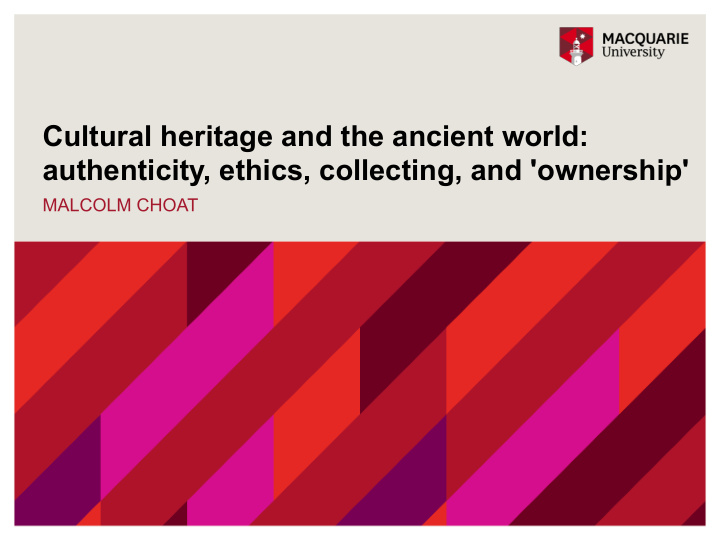



Cultural heritage and the ancient world: authenticity, ethics, collecting, and 'ownership' MALCOLM CHOAT
Issues and Principles 1. The material cultural record of antiquity. > the modern history of an artifact is as important as its ancient history. 2. Cultural heritage. > intangible cultural heritage is just as important as the tangible 3. The ‘ownership’ of cultural heritage > no one ‘owns’ the past. 4. Balance and equality Malcolm Choat malcolm.choat@mq.edu.au 2
Balance METHODOLOGY AND APPROACH ‘The Investigation of Ancient Sites and Sources’ (Ancient History Syllabus, p. 28) Image Malcolm Choat malcolm.choat@mq.edu.au 3
Balance IN: • Sources and approaches Historiography – of the 19 th century and the present day • • Modern readings • Examples of practitioners • Problematising the disciplines Malcolm Choat malcolm.choat@mq.edu.au 4
Balance • Never use these fictional characters as examples of archaeologists. Malcolm Choat malcolm.choat@mq.edu.au 5
Modern uses of ancient Evidence USING ARTIFACTS TO CONNECT TO THE PAST Malcolm Choat malcolm.choat@mq.edu.au 6
Modern uses of ancient Evidence POLYCHROME STATUES Sarah Bond, ‘Whitewashing Ancient Statues: Whiteness, Racism And Color In The Ancient World’, Forbes, 27/4/17 https://www.forbes.com/sites/drsarahbond/ 2017/04/27/whitewashing-ancient-statues- whiteness-racism-and-color-in-the- ancient-world/ Malcolm Choat malcolm.choat@mq.edu.au 7
Historical Authentication and Reliability EXAMPLES OF FORGERIES FOR DISCUSSION • ‘Gospel of Jesus Wife’ • Jehoash Inscription • Dead Sea scrolls • Getty Kouros Image Malcolm Choat malcolm.choat@mq.edu.au 8
Historical Authentication and Reliability WEB RESOURCES • www.forgingantiquity.com ― Website of the Macquarie University ARC-funded project on fake papyri, ‘Forging Antiquity’. • https://markersofauthenticity.com ― Blog of the Macquarie University interdisciplinary research cluster ‘Markers of Authenticity’. • Conference ‘Manuscripts from the margins’, 22 September, Macquarie University ‘Faking it’ – exhibition at the Museum of Ancient Cultures, Macquarie • University, mid-August–October. Malcolm Choat malcolm.choat@mq.edu.au 9
Artifacts PROVENIENCE AND PROVENANCE • Provenience: where an object was found (or sometimes made) ― Need to know archaeological find-spot and circumstances of finding. • Provenance: collection history – how did the object get from the ground to where it is now? Malcolm Choat malcolm.choat@mq.edu.au 10
Artifacts PROVENIENCE AND PROVENANCE • What is the modern history of the artifact? ― how did we come to have it? ― Where was it found? ― When? ― By who? ― Do we know? ― If not, why? • What happens if we take unprovenanced artifacts out of our analysis? Malcolm Choat malcolm.choat@mq.edu.au 11
Ancient Sites TEMPLE OF BEL AT PALMYRA Malcolm Choat malcolm.choat@mq.edu.au 12
Ancient Sites in modernity THE VILLAGE IN THE TEMPLE OF BEL AT PALMYRA 13
Ancient Sites in modernity THE VILLAGE OF GURNEH IN WEST THEBES Malcolm Choat malcolm.choat@mq.edu.au 14
Reconstructed Ancient Sites THE DEIR EL-BAHRI (‘NORTHERN MONASTERY’) The Monastery of Phoibammon, 1890s The Funerary Temple of Hatshepsut, today Malcolm Choat malcolm.choat@mq.edu.au 15
Ancient Sites in modernity THE VILLAGE IN THE TEMPLE OF BEL AT PALMYRA 16
Reconstructed Ancient Sites THE TRIUMPHAL ARCH OF PALMYRA OFFICE | FACULTY | DEPARTMENT 17
Egypt, present and past ‘Like the treatment of Native Americans, the collection of Egyptian skeletons is rooted in colonialism and a disregard for the wishes of the dead. But, while living Native Americans claim descent from their continent’s first peoples, the Islamic communities of Egypt do not claim continuity with the people who built the pyramids . And even if they did, mummies were gathered to glorify ancient Egyptians while Native American skeletons were long collected to dehumanize indigenous peoples. The modern-day Egyptian government has given its consent for the excavation of tombs.’ Chip Colwell, ‘The Long Ethical Arc of Displaying Human Remains’, Atlas Obscura , November 16, 2017. Malcolm Choat malcolm.choat@mq.edu.au 18
Egyptian identification with the past Alaa Awad’s mural from National Military Museum, Cairo. Mohammad Mahmoud Street, Cairo Malcolm Choat malcolm.choat@mq.edu.au 19
Prohibitions on disturbing the dead FROM PHARAONIC EGYPT • As for any man who will do something against this (tomb), there will be judgement with him by the Great God” ― 6th Dynasty tomb of Djenwen. • “As for anyone against this tomb in my place: the one who disturbs is a criminal” ― 25th Dynasty Block Statue of Montuemhat from Karnak. • “As for anyone who will desecrate my corpse in the necropolis, who will remove my statue from my tomb, he will be a hated one of Re, he will not receive water from the water-jar of Osiris, he will not hand over his possessions to his children, ever.” … “As for the one who desecrates my place, who will damage my tomb or remove my corpse, the soul of Re will hate him, he will not hand over his possessions to his children, his heart will not rest in life, he will not receive water in the necropolis, his soul will be destroyed forever.” ― 18th Dynasty Statue of Wersu from Koptos. Malcolm Choat malcolm.choat@mq.edu.au 20
Cultural Heritage and Museums • Don’t begin and end with repatriation debates ― If you do, go beyond the famous cases (e.g. Parthenon marbles) • Don’t present out of date debates ― Universalist claims to heritage, arguments of better access, better preservation, etc. are increasingly problematic • The past cannot be ‘owned’. • It cannot be commodified, or its value expressed in financial terms. • Explain the legal picture, but promote discussion of an ethical approach to the past. Malcolm Choat malcolm.choat@mq.edu.au 21
Cultural heritage and the ancient world: authenticity, ethics, collecting, and 'ownership' MALCOLM CHOAT
Recommend
More recommend